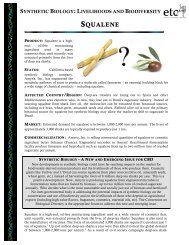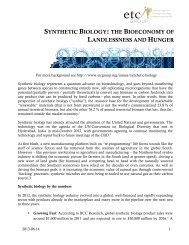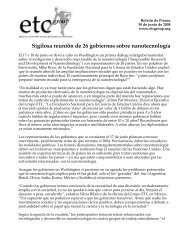The New Biomassters - Convention on Biological Diversity
The New Biomassters - Convention on Biological Diversity
The New Biomassters - Convention on Biological Diversity
Create successful ePaper yourself
Turn your PDF publications into a flip-book with our unique Google optimized e-Paper software.
What Is Switching?<br />
Switch 1: Switching Power – Burning<br />
biomass for heat and bioelectricity<br />
At present, the Internati<strong>on</strong>al Energy Agency (IEA) reports<br />
that 10.1% of global primary energy comes from biomass,<br />
mostly wood, dung and straw burned for traditi<strong>on</strong>al cooking<br />
and heating. However, they predict this amount could increase<br />
to 25% by 2030, 212 a massive upswing reflecting the new<br />
commercial race to burn biomass to generate electricity.<br />
Low Hanging Fruit<br />
In a few short years, the electricity industry has embraced<br />
biomass burning as a strategy to not <strong>on</strong>ly cut costs but also to<br />
capture carb<strong>on</strong> credits and meet renewable energy targets.<br />
Biomass power plants now exist in over 50 countries around<br />
the world and supply a growing share of electricity. Globally,<br />
an estimated 54 GW of biomass power capacity was in place<br />
by the end of 2009. 213 In many ways, burning biomass is the<br />
low hanging fruit of the renewable energy world. It requires<br />
little or no new technology and can be easily implemented in<br />
existing industrial facilities by switching feedstock from<br />
mineral oils to vegetable oils, or from coal to wood pellets<br />
(compacted sawdust). As such, nati<strong>on</strong>al and regi<strong>on</strong>al<br />
authorities often target biomass burning as a simple<br />
‘transiti<strong>on</strong>al’ form of supposedly renewable energy. In<br />
particular, the practice of co-firing wood in existing coal<br />
power plants is becoming widely practiced. This is d<strong>on</strong>e<br />
simply by mixing biomass with coal in the burning chambers<br />
of power plants that in turn drive steam turbines.<br />
Biomass Burning in the USA<br />
<str<strong>on</strong>g>The</str<strong>on</strong>g> United States generates over <strong>on</strong>e third of all biomass<br />
electricity – making it the largest producer of biomass<br />
power in the world. 214 As of October 2010, the grassroots<br />
group Energy Justice Network had mapped over 540<br />
industrial power facilities burning biomass in the U.S.,<br />
with a further 146 slated to be built. 215 Eighty biomass<br />
power plants c<strong>on</strong>nected to the electrical grid in 20 U.S.<br />
states currently generate about 10GW of power, 216 which<br />
is half of all U.S. “renewable energy” in an industry worth<br />
$1 billi<strong>on</strong>. 217 Since 2000, biomass generati<strong>on</strong> <strong>on</strong> the<br />
electrical grid has risen 25% to about 2,500 megawatts,<br />
according to the Biomass Power Associati<strong>on</strong>. 218<br />
Biomass Power in the South<br />
According to REN21 (Renewable Energy Policy Network for<br />
the 21st century), biomass power has also grown significantly<br />
in the global South, particularly in the BRICS countries<br />
(Brazil, India, China and South Africa). Other countries with<br />
bioelectricity producti<strong>on</strong> include Costa Rica, Mexico,<br />
Tanzania, Thailand, and Uruguay. China’s share of biomass<br />
power in 2009 was 3.2 GW and the country plans to produce<br />
up to 30 GW by 2020. India is aiming for 1.7 GW of capacity<br />
by 2012. Brazil has over 4.8 GW of biomass electricity, almost<br />
entirely produced from sugarcane bagasse at sugar mills. 219<br />
Illustrati<strong>on</strong>: the<br />
Beehive Collective<br />
Counting the Costs of Biomass<br />
Electricity I: Gobbling fields and forests<br />
<str<strong>on</strong>g>The</str<strong>on</strong>g> most straightforward impact of new biomass power<br />
facilities is the increased requirements for biomass, chiefly<br />
wood, required 24 hours a day to keep the turbines turning.<br />
According to a report <strong>on</strong> biomass availability prepared by the<br />
Massachusetts Department of Envir<strong>on</strong>mental Resources,<br />
13,000 t<strong>on</strong>nes of green biomass are required to generate <strong>on</strong>e<br />
megawatt of biomass power for <strong>on</strong>e year. 220 As U.S. activist<br />
Josh Schlossberg puts it, these facilities are “gaping mouths<br />
waiting for a c<strong>on</strong>stant supply of forest.” 221<br />
<str<strong>on</strong>g>The</str<strong>on</strong>g> world’s largest wood-burning biomass power stati<strong>on</strong>, the<br />
Prenergy plant at Port Talbot in Wales (currently under<br />
c<strong>on</strong>structi<strong>on</strong>), aims to import over 3 billi<strong>on</strong> t<strong>on</strong>s of woodchips<br />
from the U.S., Canada, South America and Eastern Europe.<br />
According to watchdog Biofuelwatch, the land area needed to<br />
grow this much biomass could be as large as <strong>on</strong>e half-milli<strong>on</strong><br />
hectares – ensuring the deforestati<strong>on</strong> of an area three times the<br />
size of Liechtenstein every year. 222<br />
ETC Group 42 www.etcgroup.org
















